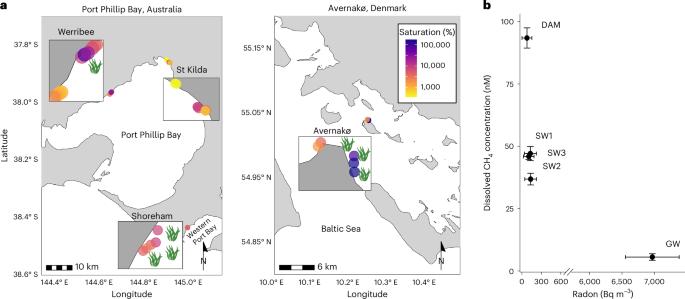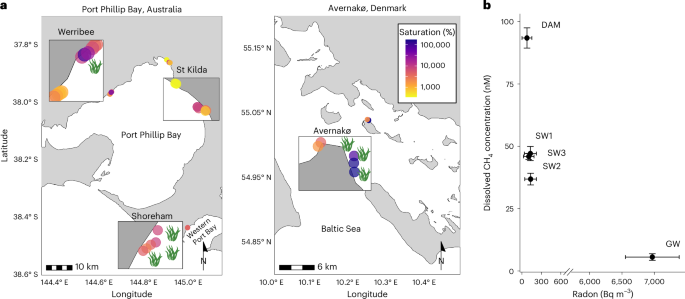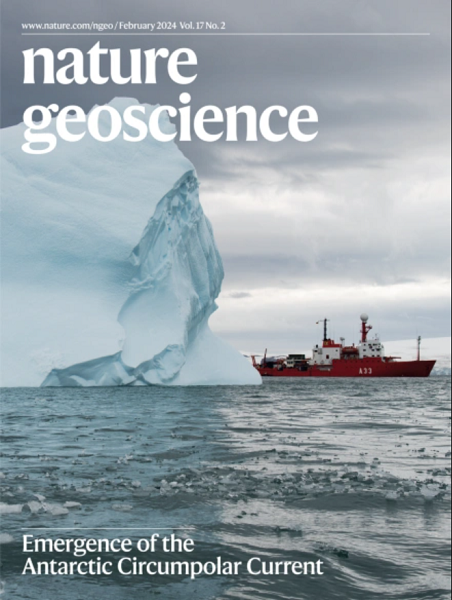利用海藻和海草代谢物的耐氧产甲烷菌驱动的沿海甲烷排放
IF 16.1
1区 地球科学
Q1 GEOSCIENCES, MULTIDISCIPLINARY
引用次数: 0
摘要
人们认为产甲烷仅限于严格缺氧的环境。虽然含氧海洋是已知的甲烷来源,但有人认为甲烷的产生是由甲基膦酸降解细菌和潜在的其他来源驱动的,而不是由产甲烷的古细菌驱动的。本文结合生物地球化学、宏基因组学和培养实验,开展原位监测和移地操作实验,证明了古细菌在频繁氧化的沙质沉积物中快速产生甲烷。研究表明,沙质沉积物的甲烷排放不会被反复的氧气暴露所抑制,这一活动是由广泛分布于沙质沉积物表层的耐氧甲基营养化产甲烷菌(主要是Methanosarcinaceae)驱动的。此外,我们发现甲烷排放是由甲基化的海藻和海草代谢物驱动的,揭示了初级生产和温室气体排放之间的反馈循环。本文章由计算机程序翻译,如有差异,请以英文原文为准。


Coastal methane emissions driven by aerotolerant methanogens using seaweed and seagrass metabolites
Methanogenesis is thought to be limited to strictly anoxic environments. While oxygenated oceans are a known methane source, it is argued that methane production is driven by methylphosphonate-degrading bacteria and potentially other sources rather than by methanogenic archaea. Here we develop in situ monitoring and ex situ manipulation experiments, combined with biogeochemical, metagenomic and culture-based experiments, to show that methane is rapidly produced by archaea in frequently oxygenated sandy sediments. We show that methane emissions from sandy sediments are not inhibited by repeated oxygen exposure and suggest the activity is driven by aerotolerant methylotrophic methanogens (primarily Methanosarcinaceae) broadly distributed in the surface layers of sandy sediments. Moreover, we show that methane emissions are driven by methylated seaweed and seagrass metabolites, revealing a feedback loop between primary production and greenhouse gas emissions. Experiments suggest aerotolerant archaea produce methane in the surface layers of coastal sandy sediments and that this activity is driven by seaweed and seagrass metabolites.
求助全文
通过发布文献求助,成功后即可免费获取论文全文。
去求助
来源期刊

Nature Geoscience
地学-地球科学综合
CiteScore
26.70
自引率
1.60%
发文量
187
审稿时长
3.3 months
期刊介绍:
Nature Geoscience is a monthly interdisciplinary journal that gathers top-tier research spanning Earth Sciences and related fields.
The journal covers all geoscience disciplines, including fieldwork, modeling, and theoretical studies.
Topics include atmospheric science, biogeochemistry, climate science, geobiology, geochemistry, geoinformatics, remote sensing, geology, geomagnetism, paleomagnetism, geomorphology, geophysics, glaciology, hydrology, limnology, mineralogy, oceanography, paleontology, paleoclimatology, paleoceanography, petrology, planetary science, seismology, space physics, tectonics, and volcanology.
Nature Geoscience upholds its commitment to publishing significant, high-quality Earth Sciences research through fair, rapid, and rigorous peer review, overseen by a team of full-time professional editors.
 求助内容:
求助内容: 应助结果提醒方式:
应助结果提醒方式:


